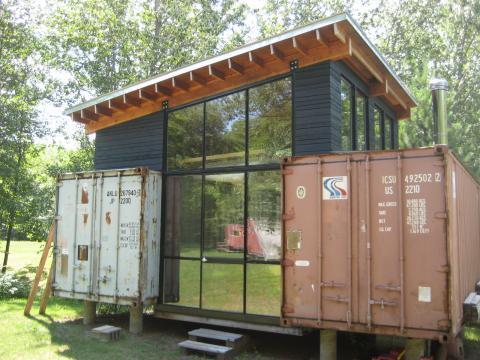
Your inner recycler wants to live in a shipping container! Shipping containers are just that – reused containers that were once used for freight movement on trains or barges. Turns out, they can make a pretty sweet set-up on land, too.
Shipping containers are flexible housing options in that you can decide how many you want to add together to make the perfect sized dwelling. What’s more, is you can be flexible with how you attach them – they can be stacked vertically, lined up horizontally, or both! So, for example, you can attach container #2 on top, beside, or behind container #1!
How are shipping containers homes constructed? Shipping containers are purchased and hauled to the building site. A concrete slab is poured for a foundation. If you choose to have utilities (running water, electricity, etc.), those are run up through the foundation before the shipping container is placed. Next, the sides (and/or tops, and/or bottoms) are sawed where the containers will be connected. The openings where the metal has been removed are then usually framed out for stabilization. The shipping containers are then placed in the structure that the homeowner has selected, and welded together.
Shipping containers make Basmati’s Sustainable Housing Series because they are make out of recycled material. Melting down shipping containers is wasteful and emits a lot of pollution. The other alternative, shipping the containers back to where they came from, is expensive and causes transportation pollution (these things are pretty huge!). The thick and sturdy construction (metal) of a shipping container also makes for great insulation, meaning you don’t need to use as much energy to keep the home cool or warm. They also support off-grid features like solar panels. Further, shipping containers can be designed in a way that can eliminate borders from the outside; often, people make huge windows or garage doors on the sides of their shipping containers that blur the boundaries and allow people to live fluidly with the outdoors. Shipping containers can also be built in town or in traditional neighborhoods, which can provide encouragement for neighbors to live more sustainably, too. By fitting in as a neighborhood structure, shipping containers remind others that you don’t necessarily have to give up all of the modern conveniences like electricity, plumbing, or even location, in order to live more sustainably.
Shipping containers can be made to look like modern housing, or left as they are to give off the rustic vibe. There are two main sizes for shipping containers: 20 feet long, and 40 feet long – both at about 8 feet wide. Many people live in one shipping container at 160 square feet! Decks, additional rooms, and roofs can be built onto the shipping container for additional architectural pizzazz.
So, how much embracing your inner recycler cost? One shipping container costs anywhere from $1,000 - $5,000 depending on the size, etc. This price usually includes transportation and unloading of the shipping container at your site. This price does not include any kind of furnishings, fixtures, flooring, etc., but it’s a pretty inexpensive (and sturdy) foundation for a home!
Do you live in a sustainable housing structure? Share your story below!
Cover Image Source: Wikimedia








